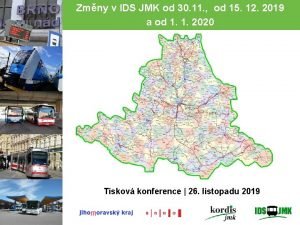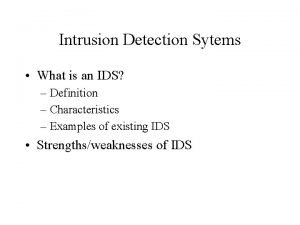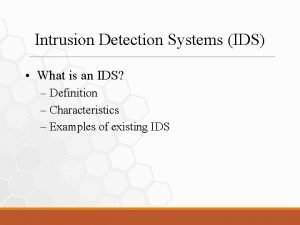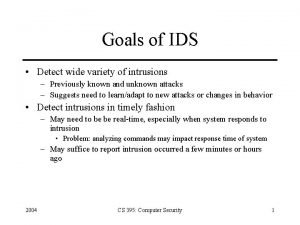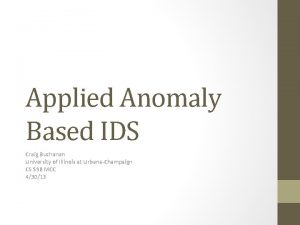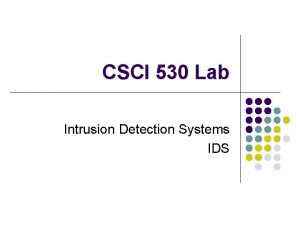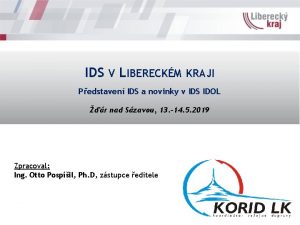Universal Tree of Life u Universal tree ids
















- Slides: 16

Universal Tree of Life u Universal tree ids the roadmap of life. It depicts the evolutionary history of the cells of all organism and the criteria reveals 3 dimensions. u The root of the universal tree represents a point in evolutionary history when all extend life on earth share a common ancestor, the universal ancestor.

This universal tree illustrates the hypothesis that all of life is related and can be divided into three major clades, often referred to as the three domains: Archaea, Bacteria, and Eukaryota.



The Three Domain Discovered based on comparing of sequences of the r. RNA from different kinds of cell. l Discovered by Carl, R Woese in 1978 l In this classification system there are 2 prokaryotic groups. They are Bacteria & Archaea. l They have similarity in appearance. l

§ In this widely accepted scheme plants, animal, fungi and protists are kingdoms in the domain of Eukarya. § Organisms are classified into three domain accorging to their cell types. § For example, Differences in r RNA, membrane lipid structure, transfer RNA molecule & sensetivity to antibiotics.


Bacteria § Includes all pathogenic and non pathogenic prokaryotes. § Found in soil, air and water. Characteristics § Cell wall contains peptidoglycane. § Closely related to eukaryotes. § Membrane lipid is composed of straight carbon chains attached to glycerol by ester linkage. § 1 st amino acid in protein synthesis is formaldehyde.

modern analogs all aerobic, some groups either unidentified (yet) or lost sulfur metabolism, thermophilic other contemporary groups Aquificales – most deeply rooted bacterial species

Archaea n n n n Archaea includes prokartotes. Most primitive organism. Donot have peptidoglycane layer in their cell wall. Membrane lipid is composed of branched carbon chain attached to glycerol by Ether linkage. Often live in Extreme environment. Carry out unusal metabolic process. 1 st amino acid in protein synthesis is Methionine.

Ø Include three mejor groupsØ Methanogens that are strict anaerobe that produce methane. Ø Extreme halophile which require high concentration of salt for their survival. Ø Hyperthermophile which normally grow in hot environment.

Extreme Environments and Microbial Evolution “Extremophiles” are extremely diverse Typically, extremes in radiation, temperature, salt, pressure, p. H, drought, reducing conditions Some extreme conditions thought to prevail on ancient Earth… Therefore, Hypothesis: organisms like these dominated ancient Earth, and their genetic lineages are therefore ‘old’ compared to organisms adapted to modern, more temperate, conditions Most extremophiles are Archaea e. g. , hyperthermophiles, halophiles, methanogens

Phylogenetic trees representing major groups in the Archaea, noting the positions of organisms commonly found in extreme environments: methanogens, halophiles, and thermophiles. (Ogunseitan 2005).

Eukarya l Cell type eukaryotic. l Cell wall contains carbohydrate. l Membrane lipid is composed of straight carbon chains attached to glycerol by ester linkage. l First amino acid in protein synthesis is Metionone.

The oldest known fossils are the remains of prokaryotes that lived more than 3. 5 billion years ago. n Eukaryotic cell evolved more recently about 1. 4 billion years ago. n

Different molecules, different trees r. RNA tree provides one phylogeny, but other molecules suggest others For example, r. RNA suggests Eukarya more closely related to Archaea than to Bacteria, But, mitochondrial and chloroplast genomes suggest origin from bacteria (not archaea) Within bacteria, genes coding for nitrogen fixation suggest phylogenies different from r. RNA
